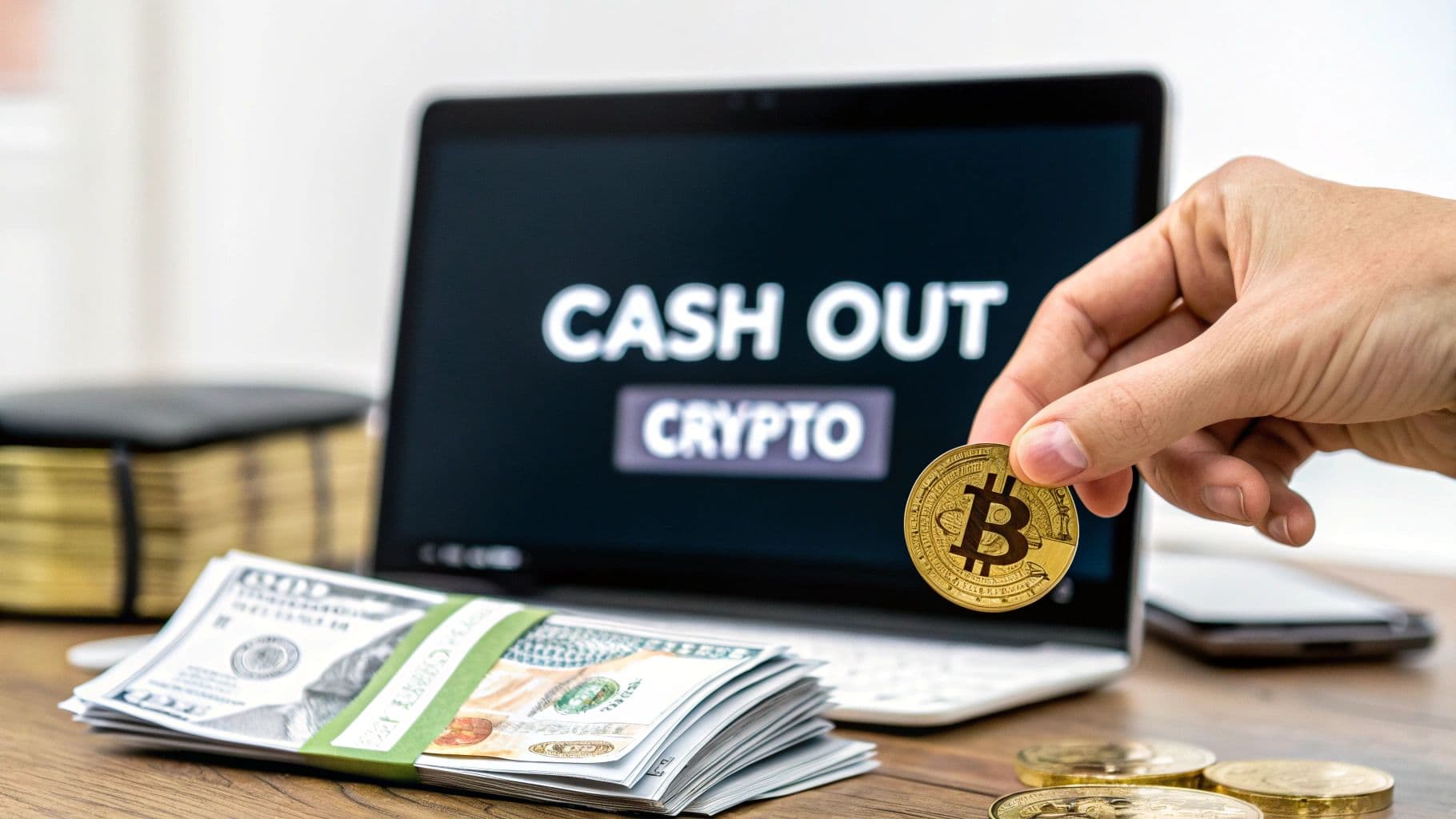
How to Cash Out Cryptocurrency Safely
Ready to turn your digital assets into actual cash you can spend? The good news is it's more straightforward than you might think. The process really just boils down to picking the right pathway for your specific situation. You've got a few solid options: using a centralized exchange (CEX), going through a peer-to-peer (P2P) platform, or even using a crypto payment processor.
Each route comes with its own set of pros and cons when it comes to speed, fees, and privacy. Let's break them down.
Crypto Cash-Out Methods at a Glance
Choosing the best way to cash out your crypto really depends on what's most important to you at that moment—speed, low fees, or privacy. This table gives you a quick snapshot of the main differences between the most common methods.
| Method | Best For | Typical Speed | Common Fees | Privacy Level |
|---|---|---|---|---|
| Centralized Exchange (CEX) | Speed and simplicity | 1-5 business days | Trading fees (0.1%-1%), withdrawal fees | Low (KYC required) |
| Peer-to-Peer (P2P) Trading | Flexibility and potentially better rates | Varies (minutes to hours) | Varies by seller (often 0% - 2%) | Moderate to High |
| Payment Processors (e.g., BlockBee) | Businesses and frequent withdrawals | Nearly instant to a few hours | Transaction/processing fees (e.g., 0.5%) | Varies by service |
As you can see, there's a clear trade-off. A centralized exchange is fast and reliable, but you'll have to give up some privacy. P2P offers more control but might take a bit more effort. Understanding these differences is the first step to a smooth cash-out experience.
Choosing Your Crypto to Cash Pathway
When you decide it's time to take profits or move your crypto back into fiat, you’re not just selling an asset. You're picking a financial off-ramp, and choosing the right one from the start will save you a ton of time, money, and potential frustration. The three main routes cater to very different needs, from getting instant spending power to having maximum control over the transaction.
Centralized exchanges are, without a doubt, the most beaten path for converting crypto. Platforms like Coinbase or Kraken handle an incredible volume—we’re talking hundreds of billions of dollars’ worth of crypto being off-ramped this way every year.
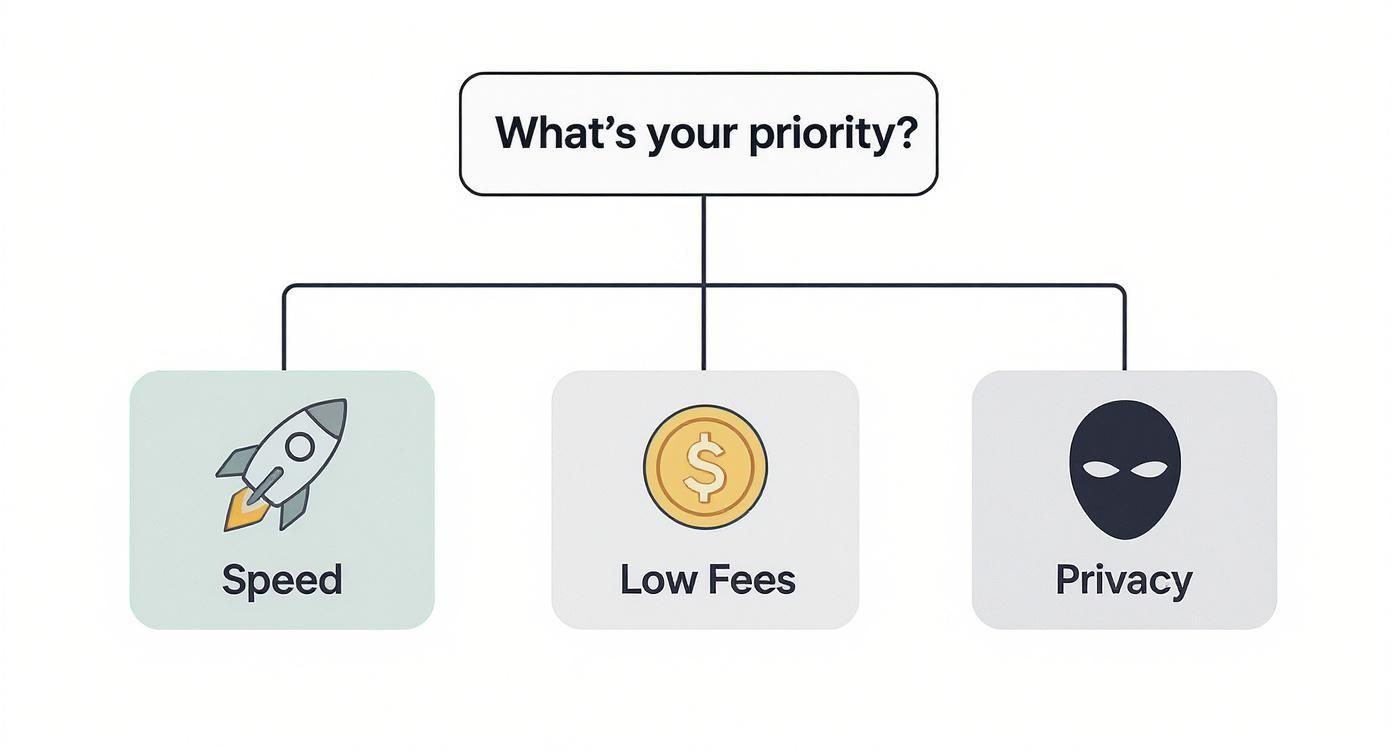
So, what should you focus on? Your choice really hinges on one simple question: What matters most to you right now?
- Speed: Do you need the money in your bank account by tomorrow?
- Cost: Is your main goal to minimize fees and keep as much of your crypto's value as possible?
- Privacy: How do you feel about uploading your ID and other personal documents to a third-party platform?
If you're after speed, a traditional exchange is usually your best bet. If you're hunting for lower fees or want more privacy, a P2P platform might be a better fit. Getting a handle on how these factors interact is a big part of mastering the art of cryptocurrency to fiat conversion. Each method truly offers a distinct set of trade-offs.
My Two Cents: There's no single "best" way to cash out for everyone. A CEX gives you reliability and speed. A P2P marketplace offers flexibility and sometimes better rates. A payment processor is great for automation and business. Take a moment to think about what you need—speed, low cost, or privacy—before you make a move.
Cashing Out Through a Centralized Exchange
For most people, the simplest and most direct way to turn crypto into cash is through a centralized exchange (CEX). If you've ever used platforms like Coinbase, Kraken, or Binance, you're already familiar with the concept. They act as a trusted bridge between the crypto world and your traditional bank account.
Think of it this way: you send your crypto to the exchange, they handle the sale on their marketplace, and then they wire the cash right back to you. It's a popular route for a reason—it’s reliable and pretty straightforward, especially if you're not looking to deal with peer-to-peer transactions.
Getting Your Account Ready to Go
Before you can pull any money out, you’ll have to go through the exchange’s identity verification, which everyone in the industry calls Know Your Customer (KYC). This is a one-time, mandatory step where you’ll upload ID and provide some personal details. It’s how these platforms stay compliant with financial regulations.
This KYC process is a big part of what makes exchanges a relatively secure off-ramp. These compliance hurdles are designed to weed out bad actors. While exchanges used to be a hotbed for shady transactions, better verification and cooperation with law enforcement have made them a much riskier place for criminals to operate.
My Advice: Don't put off KYC until the day you need your money. Get your account verified well in advance. The approval process can sometimes take a few days, and you don’t want that delay when you’re ready to cash out. You can learn more about the specifics in our detailed guide on what KYC in crypto involves.
The Step-by-Step Path to Your Bank Account
Once you're verified, the actual process of cashing out is pretty logical. It’s just a few steps to get the funds from your personal wallet into your bank.
First things first, you need to get your crypto onto the exchange. You'll send it from your self-custody wallet (like a Ledger or a mobile app) to the unique deposit address the exchange gives you for that specific coin. I can't stress this enough: double-check that address. A typo here can mean your funds are gone forever.
Next, you sell. Once your deposit is confirmed on the blockchain, you can go ahead and place a sell order. You’re simply trading your crypto, like Bitcoin, for a fiat currency, like US Dollars. Most platforms have a simple "market sell" button that executes the trade instantly at the current price.
Finally, you withdraw the cash. With the fiat currency sitting in your exchange account, you just need to initiate a withdrawal to your linked bank account. Tell them how much to send, confirm it, and you're done. Depending on your bank and where you live, the transfer can be almost instant or take a few business days to show up.
Watch Out for the Fees
This convenience isn’t free, of course. To know exactly how much cash will hit your account, you need to be aware of the different fees you'll encounter along the way.
- Trading Fees: Every time you sell, the exchange takes a small cut. This is usually a percentage of the trade value, often somewhere between 0.1% to 0.5%.
- Withdrawal Fees: This is what the exchange charges to send the fiat to your bank. It’s often a flat fee that can be anywhere from free to $25 or more, depending on if it's a standard bank transfer (ACH) or a wire.
- The Spread: This one’s a bit of a "hidden" cost. It’s the tiny difference between the buy price and the sell price on the platform's order book. It’s not a direct fee, but it does slightly chip away at the final amount you receive.
Add all those up, and you’ll have a clear picture of what the entire cash-out process will cost you. No one likes surprises when it comes to their money.
Selling Directly on Peer-to-Peer Platforms
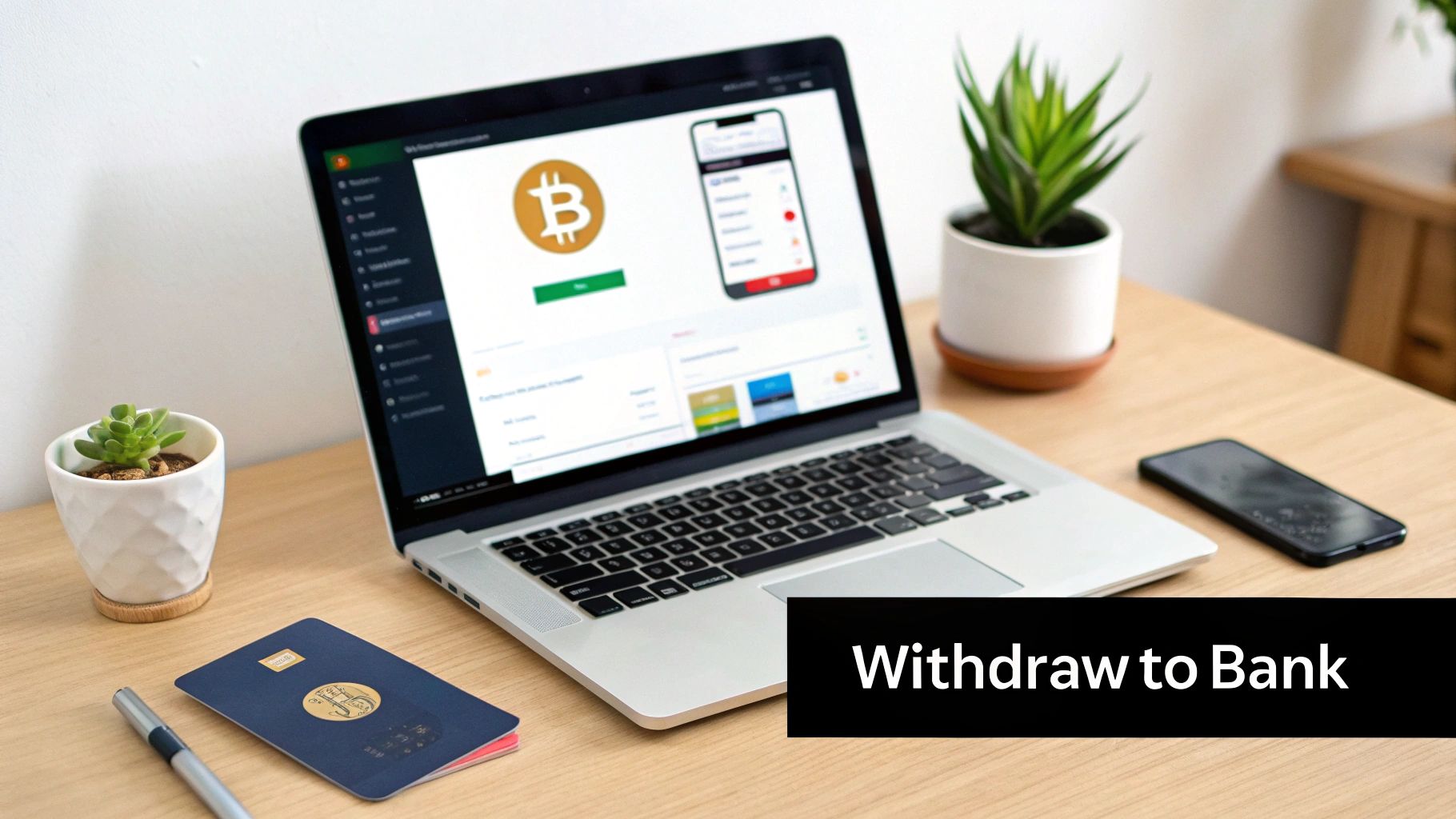
If you're someone who likes a bit more control over your trades and prefers to step away from the typical exchange setup, then you should seriously consider peer-to-peer (P2P) platforms. It’s a completely different way of doing things. Instead of placing an order on a massive open market, you're selling your crypto directly to another person.
The platform's main job is to act as a trusted middleman. It holds your crypto in escrow until you give the green light that the cash payment has landed in your account. This setup lets you call the shots on your price and pick from a huge variety of payment methods.
Say you want to sell $500 worth of Bitcoin. On a P2P service like Paxful or the now-rebranded Noones, you can create a specific offer saying you’ll only accept payment via PayPal or a direct bank transfer. That kind of flexibility is exactly why so many people get comfortable cashing out their crypto this way.
Crafting Your Offer and Setting Your Price
Think of creating a sell offer on a P2P platform as opening up your own digital storefront. You get to lay down all the rules of the sale, which is a massive leg up compared to the rigid structure of most centralized exchanges.
The first thing you’ll tackle is the price. You can list your crypto for a fixed amount or get a little more strategic by setting a price that floats with the market—say, 2% above the current spot price. This little premium can cover your time and any fees you might get hit with from your payment processor.
Next up, you decide how you want to get paid. This is where P2P really comes into its own. The possibilities are often much broader than on a standard exchange:
- Bank Transfers: Straight-up deposits into your bank account.
- Online Wallets: Popular services like PayPal, Skrill, or Wise.
- Gift Cards: You can even trade your crypto for things like Amazon gift cards.
- Cash: For the truly adventurous, in-person cash trades are sometimes an option, but be aware of the higher risks involved.
You'll also need to set your trade limits. For instance, you could set a minimum trade of $50 and a maximum of $1,000. This helps filter out time-wasters and attract the specific buyers you want to deal with.
Navigating the Trade with Security in Mind
P2P trading puts a lot of power in your hands, but that also means you need to be on your toes. You're dealing directly with a stranger, so staying safe is your responsibility.
The platform’s escrow service is your best friend here. It's a neutral zone that holds onto your crypto and won't release it to the buyer until you have confirmed that their payment is received and cleared.
Crucial Takeaway: I can't stress this enough—never release your crypto from escrow until you have logged into your own bank or payment account and seen the money there with your own eyes. Scammers love to send fake payment screenshots or use payment methods that can be reversed after the fact.
Before you agree to a trade, do a little homework on the buyer. Check their profile for things like a long trading history, positive feedback, and whether their identity has been verified. A buyer with 100+ positive trades and a verified badge is infinitely more trustworthy than a brand-new account with no history.
And if anyone ever tries to get you to chat or trade outside of the platform, that’s a massive red flag. It’s almost always a scam. Stick to the platform’s system, stay vigilant, and P2P can be a fantastic and profitable way to cash out your crypto.
Spending Crypto with Debit Cards and Services
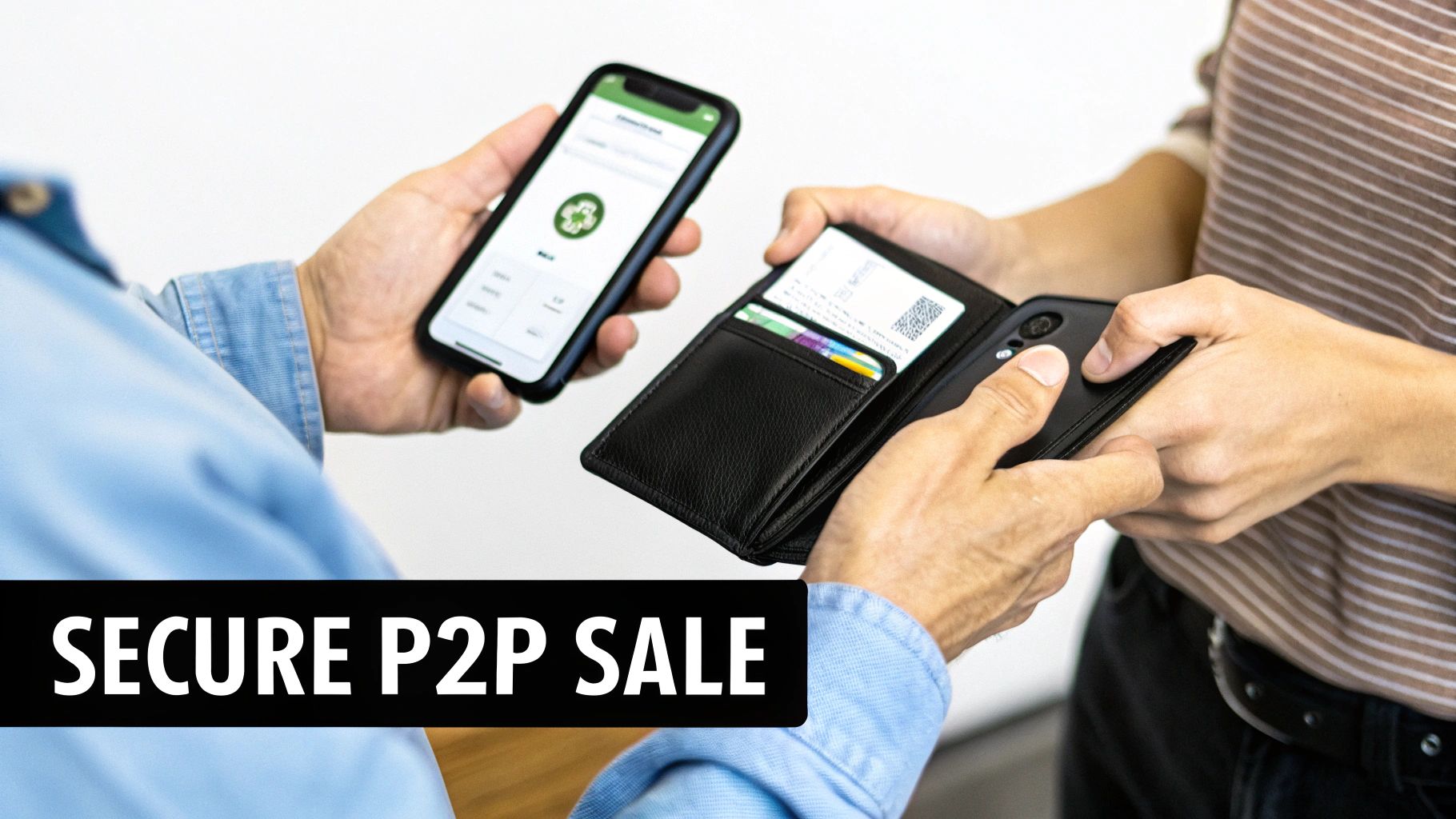
What if the best way to cash out your crypto didn't involve cashing out at all? A growing number of services now let you spend your digital assets directly, pretty much anywhere. This is all about bridging the gap between your crypto portfolio and your daily life, making your holdings as spendable as the cash in your bank account.
The most common way to do this is with a crypto debit card. I've used a few, and the experience is surprisingly smooth. Companies like Crypto.com or BitPay issue physical and virtual cards tied directly to your crypto balance. When you go to pay for something, the service handles the conversion to dollars, euros, or whatever the local currency is, right there at the point of sale. It's a fantastic way to access your crypto's value without waiting for a bank transfer to clear.
How Do These Cards Actually Work?
Think of a crypto debit card as an on-the-fly currency converter that fits in your wallet. It takes your Bitcoin, Ethereum, or stablecoins and translates them into the fiat currency that traditional payment systems, like Visa or Mastercard, understand.
Behind the scenes, the process is pretty slick:
- Real-Time Conversion: The moment you tap or swipe, the card provider sells just enough of your crypto at the current market price to cover your purchase.
- Traditional Payment: That fiat amount is then sent through the payment network to the merchant, who has no idea crypto was even involved.
- Updated Balance: Your crypto wallet balance is immediately debited for the amount you just spent.
This whole process is nearly instant. It’s ideal for anyone who wants to use their crypto for everyday spending without the usual friction and delays of off-ramping.
Beyond Personal Spending: Getting Paid in Crypto
This direct-spend model isn’t just for buying coffee. If you're a freelancer or run a business, payment processors like BlockBee can completely change how you handle crypto payments. These platforms let you accept crypto from clients anywhere in the world and can even be set up to automatically convert those payments and settle them directly into your bank account as fiat.
This essentially puts your entire off-ramping process on autopilot. You get the benefits of accepting global crypto payments without the manual headache of converting and withdrawing each one.
A Quick Word on Taxes: This is important. Every time you spend crypto with a debit card or receive a payment that gets converted for you, it's a "disposal" of an asset. In most countries, including the U.S., this is a taxable event. You absolutely have to keep good records of these transactions to handle your capital gains (or losses) correctly come tax time.
The Real Cost of Convenience
As great as this all sounds, these services aren't free. You're paying for the convenience, and it's smart to know exactly what those costs are.
Always check the fine print for things like monthly account fees, ATM withdrawal limits, and foreign transaction charges. The big one to watch for, though, is the conversion fee or spread. This is a small percentage the service takes every time it converts your crypto to fiat for a purchase. It might seem tiny, but those little fees can add up fast if you're using the card regularly.
Managing Taxes and Security When You Cash Out
Figuring out how to cash out your crypto isn't just about finding the right platform and hitting the "sell" button. The final hurdles—handling your taxes and securing your funds—are where a successful trade can turn into a costly nightmare if you're not careful.
Let's start with the unavoidable topic: taxes. In most places, like the U.S., selling your crypto for cash is a taxable event. The moment that sale goes through, you’ve officially locked in either a capital gain or a loss, and you have to report it.
This means you absolutely must track two key figures for any crypto you sell:
- Cost Basis: What you paid to get the crypto in the first place, including any transaction fees.
- Proceeds: The total amount of cash you got back from the sale.
Your taxable gain is simply the difference between the two. Say you bought some Bitcoin for $1,000 and later sold it for $1,500. That $500 difference is your capital gain. Keeping detailed records isn't just a good idea; it's essential come tax time.
Keeping Your Funds Safe During the Transfer
When you’re ready to move your money, security has to be your top priority. Crypto transactions are irreversible, which makes the space a playground for scammers. Your personal vigilance is often the only thing standing between you and a drained account.
First things first, lock down your accounts. Two-Factor Authentication (2FA) isn't just a suggestion—it's a must. Ditch the SMS-based codes, which are vulnerable to SIM-swap attacks, and use a dedicated authenticator app or a physical security key instead.
Pro Tip: Always double-check wallet addresses. Before confirming any transaction, physically compare the first and last few characters of the address you've pasted with the one you intended to use. One wrong character can send your funds into the void forever.
You also have to be on high alert for phishing scams. Scammers are experts at creating official-looking emails that trick you into logging into a fake version of an exchange or wallet service. A simple rule of thumb: never click links in emails. Always go directly to the site by typing the URL into your browser yourself.
For a deeper dive into protecting your assets, our guide on private key security is a great place to start.
Using Stablecoins and Other Final Checks
Stablecoins have become a go-to tool for cashing out. By swapping a volatile asset like Bitcoin for a stablecoin like USDC or USDT, you can effectively "lock in" your gains without immediately converting to fiat currency. This can be a smart move, especially when the market is choppy. Just remember, in many jurisdictions, even a crypto-to-crypto trade counts as a taxable event.
The scale of stablecoin usage is massive. In the 12 months leading up to September 2025, the adjusted transaction volume for stablecoins shot past an incredible $9 trillion worldwide. That completely dwarfs the payment volume processed by giants like PayPal.
As a final layer of protection, especially when you're accessing financial platforms, consider utilizing a Virtual Private Network (VPN). It encrypts your internet connection, making it much harder for anyone to snoop on your activity.
Common Questions About Cashing Out Crypto
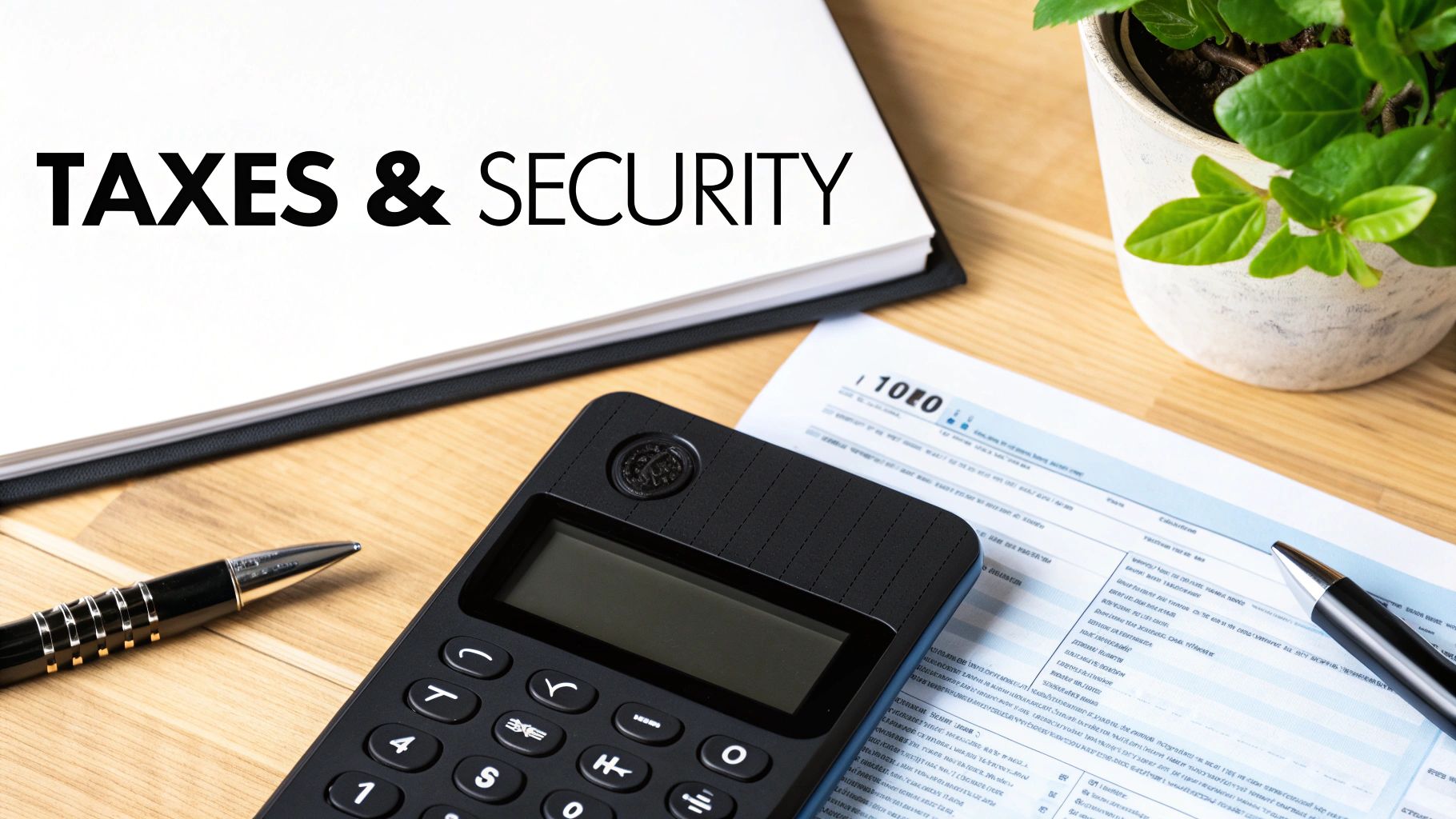
When you're ready to turn your crypto into cash, a few questions always seem to pop up. It's totally normal. Getting the right answers here can save you a ton of time, money, and headaches down the road.
Let's walk through some of the most common things people ask when they're about to off-ramp their assets. We'll cover everything from how to get your money fast to handling the dreaded tax conversation.
What Is the Fastest Way to Cash Out Cryptocurrency?
When you need cash now, speed is the name of the game. Your best bet is usually a major centralized exchange where your identity is already verified. Once you sell your crypto, withdrawing to a bank account linked with something like SEPA Instant (in the EU) or Faster Payments (in the UK) can put the money in your account in minutes.
Another surprisingly quick option is a crypto debit card. Think of it as an instant cash-out every time you swipe. You can spend your funds directly at any store that takes Visa or Mastercard, bypassing the whole bank withdrawal process entirely.
Can I Cash Out Cryptocurrency Without Paying Taxes?
This is a big one, and the answer is almost always no. In most places, like the United States and the United Kingdom, selling crypto for fiat currency is a taxable event. The moment you sell, you trigger a capital gain or loss, which you absolutely have to report on your taxes.
Trying to sidestep this is not a good idea and can lead to serious trouble. I always tell people to talk to a local tax professional who understands crypto. They'll make sure you’re squared away with your legal obligations, even if your profit was small. Keeping good records isn't just a suggestion; it's a must.
Here's something that catches a lot of people off guard: trading one crypto for another (like BTC for ETH) is often a taxable event, too. In many countries, you’re technically "selling" the first asset and have to account for any gain or loss on it.
How Much Does It Cost to Cash Out Crypto?
The cost to off-ramp your crypto isn't a single number—it really depends on the path you take. It's more of a mix of different fees you need to watch out for.
- Centralized Exchanges: You'll typically see a trading fee, which is often between 0.1% to 0.5% of the sale amount, plus a flat fee to withdraw the cash to your bank.
- P2P Platforms: These might look cheaper upfront, but sellers usually bake their profit into the exchange rate they're offering you. Always compare their rate to the market rate.
- Crypto Debit Cards: These are super convenient, but there are usually conversion fees charged every time you make a purchase, turning your crypto into fiat on the fly.
Is It Possible to Cash Out Cryptocurrency Anonymously?
Achieving true, untraceable anonymity is pretty much impossible with most modern methods. All the big, reputable exchanges require Know Your Customer (KYC) verification, where you have to submit your ID to comply with financial regulations.
Sure, some P2P trades or crypto ATMs might feel more private, but they aren't truly anonymous. These methods almost always have much lower transaction limits, can still ask for some verification, and frankly, come with higher security risks you need to be aware of.
For businesses and freelancers wanting to get a better handle on their crypto payments, BlockBee offers a non-custodial way to simplify everything. You can automate how you receive and send digital assets without giving up control. Find out more about streamlining your crypto operations.
